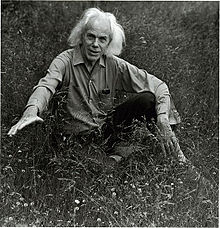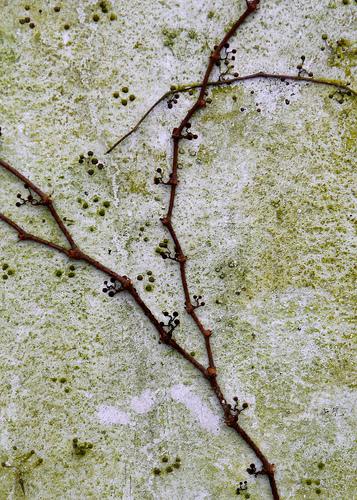 In his classic book, The Zen of Creativity (paid link), photographer, writer, and Zen master John Daido Loori describes the first time he saw his workshop leader, photographer Minor White:
In his classic book, The Zen of Creativity (paid link), photographer, writer, and Zen master John Daido Loori describes the first time he saw his workshop leader, photographer Minor White:
“He was a striking figure, well over six feet tall, with a flowing mane of white hair. He moved quietly, gracefully, and when he entered a space, he filled it completely.”
An American photographer, White (1908-1976) was influenced by the great photographers of his time – Edward Weston, Ansel Adams and Alfred Stieglitz. He, in turn, was a teacher and mentor to many, including Loori, as well as a co-founder of Aperture Magazine, still going strong.
Here are three examples of White’s contributions to contemplative photography.
1. Image as Metaphor
White continued the exploration of Stieglitz’s concept of equivalence.
“While we cannot describe its appearance (the equivalent), we can define its function. When a photograph functions as an Equivalent we can say that at that moment, and for that person the photograph acts as a symbol or plays the role of a metaphor for something that is beyond the subject photographed.” ~ John Paul Caponigro
According to White, there are levels of equivalence. The first occurs when something in an image corresponds emotionally with something in the viewer. The second level has to do with what comes up in the viewer’s mind as a result of this correspondence. The third level is the mental image the viewer retains after no longer seeing the photograph.
Through the image, the photographer or the viewer relates to the image in a way that reflects something in his or her own experience. This is very different from the Miksang approach to contemplative photography, which stays with the original perception of reality, without any interpretation.
2. Found Photographs
In his essay, Found Photographs, White describes what happened when a porcelain bowl shattered on the floor and led to the seeing of images that would not have been without that accident.
“As one porcelain bowl died a thousand thoughts were born; a score of unexplained photographs were seen to be, not accident, but photographs that found themselves. By my discipline of seeing I put myself where photographs can find themselves.”
I often find images that I call “accidental art” – the way blossoms fall on a sidewalk or the way rain obscures the view in a window or reflections in the side of a car.
White taught how to go beyond seeing images (as an observer) to experiencing them in every sense.
White was no ordinary teacher. His instructions reflect the mindset of a contemplative photographer.
- Venture into the landscape without expectations.
- Let your subject find you.
- When you approach it, you will feel resonance, a sense of recognition.
- If, when you move away the resonance fades, or if it gets stronger as you approach, you’ll know you’ve found your subject.
- Sit with your subject and wait for your presence to be acknowledged.
- Don’t try to make a photograph, but let your intuition indicate the right moment to release the shutter.
- If, after you’ve made an exposure, you feel a sense of completion, bow and let go of the subject and your connection to it.
- Otherwise, continue photographing until you feel the process is complete.
The Zen of Creativity (p. 16)
Some of this language may seem foreign to you. It does to me, although I know I’ve had the experience. The image here is one example. Walking down a street I traverse often, and suddenly the light hits a wall a certain way and I see where I haven’t seen before. I’m always drawn to clinging vines, but here it was first the soft green that had an emotional resonance with me. As I looked more closely, the small dots mirrored the dots on the vines. They became one and I was like one of those dots, standing in a certain place at a certain time.
See Minor White images here.
22 Quotes by Minor White – John Paul Caponigro

Thanks for this post, Kim. Ever since I first read about Minor White, I felt his approach resonated and could teach me so much. One of my very favorite quotes is from him: I’m always and forever looking for the image that has spirit! I don’t give a damn how it got made.” I appreciate the Miksang approach of pure perception without interpretation; at the same time, I know when I really look at some of my images that they capture something of the state of my consciousness and unconscious world.
I agree, Sherry – appreciate both. I often feel as if my perceptions reflect something in my unconscious world. Often, it becomes conscious later.
Hello Kim, I am a fairly new reader here, and I resonate so much with this post! I only dabble in “contemplative photography” – untrained and no where near a “professional level” such as yourself. I only have a Kodak Easy Share, but it has become an extension of myself, and at times I am able to capture “the spirit” of something. I find I am more impulsive, making a connection rather quickly, rather than doing a lot of “meditative waiting.” It just seems to happen that way for me… I usually find myself running to get the camera!
I love your photo by the way… It evokes a meditative sense of simplicity that is tangible… It draws me into that space. Thank you for this wonderful site! I can see that I will learn much here…
Thanks for commenting, Christine. I’ve seen your wonderful work and am so glad you connected. Intuition or perception often happens quickly (in a time sense), so I totally understand where you’re coming from.
What an extensive and interesting article about Minor White, although going into so much detail, almost intellectual, and yet at the same time intuitive and respectful, I felt as if I was losing myself. I find that I cannot analyse my photography, as I go very much with intuition and the emotional reaction I feel from what surrounds me. I did very much like this phrase: “Sit with your subject and wait for your presence to be acknowledged”.
Yes, I see that in your images, Sandra. I think you probably go through all those steps very quickly and without thinking about it. I know it happens for me that way too.
I too like the idea of waiting for presence to be acknowledged. I find my self clicking the shutter too quickly sometimes and then moving on. More time, more seeing, might reveal new layers.
Kim, Thank you for the interesting post on Minor White. One of my pastimes is researching different photographers and putting together powerpoint presentations featuring samples of their work together with quotes of theirs as well as comments from critics. I have completed one such presentation on my cousin, Francesca Woodman (American), and I am working on presentations on Lynne Cohen (Canadian) and Carrie Mae Weems (American). Thanks to you, I have started on Henri-Cartier Bresson, and now you have given me another interesting subject – Minor White. I have found this approach a good way to understand different photographers in some depth. I never ever present my material. The process itself makes it worthwhile.
John, that is a fantastic way to learn more about different artists. Thanks for sharing.
Kim – I simply adore this image. The beauty of that random pattern of dots and the green textured wall and the creeping vine – tenaciously holding on.
I’m not sure I understand the language or these concepts in an intellectual way – but I believe I feel them, at time, when everything comes together, camera in hand.
I find this post about Minor White fascinating. And I also took time to explore your site. I love your work. I too focus on Essence of Place. I too try to take to have a contemplative practice. And I love to work with photographs as metaphor. I find photography to be a practice that is life affirming in these many ways. Thank you for new insights.